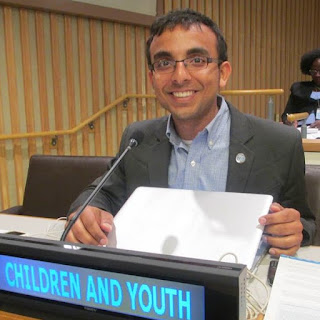Guest blog by Aashish Khullar: Implementing and Monitoring the New Urban Agenda - Comprehensive Role for Major Groups and Other Stakeholders
Aashish Khullar is one of the Organising Partners' of the UN Major Group for Children and Youth (MGCY). It is the formal engagement mechanism for young people to engage in UN processes. He focuses on the intersection of environmental and economic variables.
Mandate
Thematic progress aside, the NUA galvanises an engaged and effective role for stakeholder participation in its means of implementation (MOI) and follow up and review provisions (FuR). This is a progressive continuation of the General Assembly resolutions 70/210 and 67/290 that set forth the modalities for the Habitat III process.
The NUA, specifically, in paragraph 128 requires the UN system to closely collaborate with major groups and other stakeholders ‘to generate evidence-based and practical guidance’ to implement the NUA. In addition, paragraph 162 in follow up and review gives a proactive mandate to major groups and other stakeholders to contribute to member state reviews of the NUA.
By doing so through member state consensus on operative clauses, the NUA specifically enshrines and reinforces the institutional role of Major Groups and Other Stakeholders (MGoS) in the next steps of the NUA.
Refresher on MGoS
Originally created through Agenda 21 in 1992 and subsequently legislated through several unanimous General Assembly resolutions, this engagement modality carves out designated spaces for diverse stakeholders in the form of formal seats and participation in process-related proceedings for critical segments of society, including rights-holders groups, indigenous peoples, local authorities, the private sector and others, as opposed to a general platform that gravitates towards an artificial consensus, potentially drowning out poorly resourced constituencies and marginalized groups.
Originally identifying nine constituencies, the MGoS now is the broadest and the most self organised engagement mechanism in the UN system in the context of intergovernmental processes, and is, above all, protected through unanimous resolutions and operative clauses.
The mechanism currently includes 16 distinct constituencies, and also allocates spaces to regional groups, and focused constituencies specifically engaged in the particular processes. In addition, special space is kept open for constituencies and mechanisms from related UN frameworks (Financing for Development, Disaster Risk Reduction, World Humanitarian Summit, Sustainable Consumption and Production, Small Island Developing States. etc). Notably, all of these MGoS have guidelines for comprehensive governance, accountability and transparency reporting formally submitted to their own constituencies and the UN, with a rotating facilitators structure.
The MGoS regularly contribute to negotiations, take part in agenda setting, inform the science policy interface, engage in partnerships, report on their implementation, and even formally present shadow reports and critiques of countries’ review of their SDG implementation.
Getting it Done
Calibrating the MGoS to the next phases of the NUA requires some restructuring and retooling of the legacy of stakeholder engagement from the preparatory process. A provisional variant of an MGoS coordination mechanism, also referred to as GAP (General Assembly of Partners), is set to expire in Quito. This mechanism finds a ‘neutral’ non-operative (1) mention in paragraph 128, where the resolution merely ‘notes’ its contributions in the historical process, with no mention of an ongoing role in either implementation or follow up and review. Any extension of this mechanism or any new platform initiated by the World Urban Campaign or other organization must honor MGoS modalities, as mandated by the member states in the NUA.
In addition, this should also incorporate gaps identified in stakeholder engagement in the Habitat III process, and build on them through operationalizing agreed modalities, and borrowed practices from other processes. Direct access and contributions to negotiation proceedings is one of them.
Building on the lessons - some positive aspects but significant shortcomings - of this experimental mechanism, the MGoS need to implement and operationalize the full scope of its constituencies and range of rights and privileges by creating a new coordination mechanism, similar to what was done for the High Level Political Forum (HLPF). The HLPF is the intergovernmental avenue to oversee a network of follow up and review processes, including member state reporting of the implementation of the NUA.
Next concrete steps
● To develop a Terms of Reference (ToR) for a new coordination mechanism that reflects engagement in the post-Quito architecture consistent with MGoS modalities and best practices. This new coordination mechanism will honor the principles of pluralism and diversity (for e.g., it will not expend valuable resources on promulgating consensus proposals/documentation) and mandate transparency and accountability.
● Proactively including constituents that have not engaged in the process thus far, including reflecting regional and gender balance and emphasizing regional, national and local levels, and making appropriate linkages with other sustainable development frameworks and regional groupings
● Identify best practices and gaps in stakeholder engagement in the Habitat III process, and seek to build on those through formal modalities
Key Elements of the new Terms of Reference:
● This should include participation in the progress report of the NUA, the WUF, the 2030 Agenda process and the High Level Political Forum
● Replacing the office of an appointed ‘president’ and ‘vice president’ with rotating facilitators from different constituencies
● Institute mandatory governance, accountability and transparency mechanisms and reporting in accordance with established best practices and UN guidelines
● Create an avenue of information exchange with the Technology Facilitation Mechanism and the science policy interface proceedings with the constituencies already engaged in those arenas.
The groundwork for an effective and robust engagement mechanism within the NUA has been set and granted legal protection. It is up to us to seize the moment and bring it to light.
Endnotes
1. See GA decision 55/488 - Meaning of terms “takes note of” and “notes” is neutral and constitutes neither approval nor disapproval.






Lego Ladders redundant round tables graphics ooner we stop kidding ourselves about the New Urban Agenda the better, There is Nothing New, There is No teeth to it, No implementation Nothing on Solutions and member Nations/States GAP and all coming together at Quito
ReplyDeleteelix we await promised post-mortem of Habitat3 hope not lost in tce fe sec-gen elections ..
ReplyDeleteThis comment has been removed by a blog administrator.
ReplyDelete